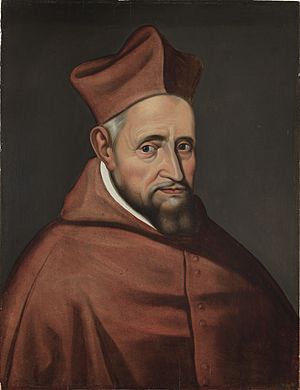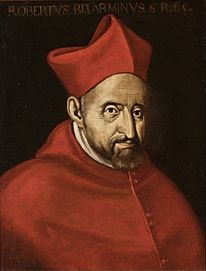Robert Bellarmine facts for kids
Quick facts for kids Robert Bellarmine |
|
|---|---|
|
|

17th-century portrait of Robert Bellarmine, Antwerp, Museum Plantin-Moretus
|
|
| Church | Roman Catholic Church |
| See | Capua |
| Appointed | 18 March 1602 |
| Enthroned | 21 April 1602 |
| Reign ended | August 1605 |
| Predecessor | Cesare Costa |
| Successor | Antonio Caetani Jr. |
| Other posts | Cardinal-Priest of Santa Prassede |
| Orders | |
| Ordination | 19 March 1570 |
| Consecration | 21 April 1602 by Pope Clement VIII |
| Created Cardinal | 3 March 1599 |
| Rank | Cardinal-Priest |
| Personal details | |
| Born | 4 October 1542 Montepulciano |
| Died | 17 September 1621 (aged 78) Rome, Papal States |
| Coat of arms |  |
| Sainthood | |
| Feast day | 17 September; 13 May (General Roman Calendar, 1932–1969) |
| Venerated in | Catholic Church |
| Beatified | 13 May 1923 Rome by Pope Pius XI |
| Canonized | 29 June 1930 Rome by Pope Pius XI |
| Patronage | Bellarmine University; Bellarmine Preparatory School; Fairfield University; Bellarmine College Preparatory; St. Robert's School, Darjeeling; canonists; canon lawyers; catechists; Robert Barron (bishop); catechumens; Archdiocese of Cincinnati; St. Robert Catholic High School, |
| Shrines | Chiesa di Sant'Ignazio, Rome, Italy |
Robert Bellarmine (born Roberto Francesco Romolo Bellarmino, October 4, 1542 – September 17, 1621) was an Italian Jesuit priest. He became a Cardinal in the Catholic Church. He was made a saint in 1930 and was also named a Doctor of the Church. This is a special title given to only 37 people for their important teachings. Robert Bellarmine was a key figure in the Counter-Reformation, which was the Catholic Church's effort to reform itself and respond to the Protestant Reformation.
Bellarmine taught theology (the study of religious faith) and later became the head of the Roman College. In 1602, he became the Archbishop of Capua. He strongly supported the changes made by the Council of Trent, which was an important meeting of Catholic leaders. He is also known for his involvement in the cases of Giordano Bruno and Galileo Galilei.
Contents
Early Life and Education
Robert Bellarmine was born in Montepulciano, Italy. His parents, Vincenzo Bellarmino and Cinzia Cervini, were from a noble family but did not have much money. His mother, Cinzia, was the sister of Pope Marcellus II.
Even as a young boy, Robert was very smart. He knew many poems by heart and wrote his own poems in both Italian and Latin. One of his religious songs is still used in a Catholic prayer book today.
In 1560, when he was 18, he joined the Jesuits, a religious order of priests and brothers. He spent three years studying in Rome. After that, he went to a Jesuit house in Mondovì, where he learned Greek. His teachers noticed how talented he was and sent him to the University of Padua to continue his studies.
Career as a Scholar and Leader
Bellarmine began his deep studies of theology at the University of Padua in 1567. In 1569, he moved to the University of Leuven in Belgium to finish his education. There, he became a priest and quickly gained a reputation as a great teacher and speaker. He was the first Jesuit to teach at the university, where he taught about the writings of Thomas Aquinas, a famous theologian.
After seven years in Leuven, he returned to Italy in 1576 due to poor health. Pope Gregory XIII asked him to teach about different religious arguments at the new Roman College (now called the Pontifical Gregorian University). His lectures were later published in four large books called De Controversias. These books discussed many of the religious disagreements of his time.
New Responsibilities After 1589
Until 1589, Bellarmine was mainly a theology professor. After the French king, Henry III of France, was killed, Pope Sixtus V sent a special representative to Paris. Bellarmine went with him as a theologian. He was in Paris during a difficult time when the city was under attack.
The next pope, Clement VIII, greatly admired Bellarmine, saying that "the Church of God had not his equal in learning." Bellarmine became the head of the Roman College in 1592. In 1598, he was made an examiner of bishops, and in 1599, he became a Cardinal. Soon after, Pope Clement made him a Cardinal Inquisitor. In this role, he was one of the judges in the trial of Giordano Bruno, who was condemned for his beliefs.
In 1602, Bellarmine was made archbishop of Capua. He had always spoken out against bishops holding many positions or not living in their dioceses. As an archbishop, he worked to put into practice the reforms from the Council of Trent. He received some votes to become pope in 1605 and 1621, but being a Jesuit made it harder for him to be chosen by the other cardinals.
The Galileo Case
In 1616, Pope Paul V asked Bellarmine to speak with Galileo. Bellarmine told Galileo about a new rule from the Church that said the idea of the Earth moving around the Sun (the Copernican doctrine) could not be defended or held. Galileo agreed to follow this.
Later, when Galileo heard rumors that he had been forced to give up his ideas and do penance, Bellarmine wrote a certificate. This certificate said that Galileo had only been told about the new rule. It explained that the Copernican idea could not be "defended or held." This certificate would have allowed Galileo to continue using the theory for calculations, as long as he did not say it was actually true.
Cardinal Bellarmine believed that there was no real proof that the Earth moved around the Sun. He thought that if there were such proof, it would go against what the Church Fathers (early Christian writers) had said about the Bible. The Council of Trent had stated that all Catholics must follow the unanimous understanding of the Church Fathers when interpreting the Bible.
In 1633, long after Bellarmine's death, Galileo was again questioned by the Church. Galileo used Bellarmine's certificate to help his defense during the trial.
Some historians and scientists, like Pierre Duhem and Karl Popper, have suggested that Bellarmine was perhaps more scientifically cautious than Galileo. Bellarmine believed that an astronomical theory might just "save the appearances" (explain what we see) without necessarily showing what "really happens."
Later Years and Death
Bellarmine retired to the Jesuit college of Saint Andrew in Rome. He passed away on September 17, 1621, at the age of 78.
Important Writings
Bellarmine's books show the style of his time. He focused on gathering as much information as possible and connecting it to theology. His works about religious debates caused many discussions and were studied for decades after his death. He studied the writings of the Church Fathers and scholastic theologians, which helped him write his book De scriptoribus ecclesiasticis (Rome, 1613). This book was later updated and expanded by others. Bellarmine also wrote the introduction to a new version of the Sixto-Clementine Vulgate, which was the official Latin Bible of the Catholic Church. He also wrote his own comments on each of the Psalms (religious songs from the Bible).
Discussions on Faith
From his research came his major work, Disputationes de controversiis christianae fidei (also called Controversiae). This book was first published in 1581–1593. It was the first big attempt to organize the many religious arguments between Catholics and Protestants. Bellarmine spent eleven years working on it while at the Roman College. In 1590, Pope Sixtus V wanted to put the first part of this book on the list of forbidden books. This was because Bellarmine argued that the Pope was not the ruler of the whole world in earthly matters, and that rulers get their power from the people, not directly from God. However, Pope Sixtus died before the list was published, and the next Pope removed the book from the list.
In 1597-98, Bellarmine published a Catechism (a book of Christian teachings) in two versions: a short one called short and a longer one called full. These books were translated into 60 languages and were used for centuries as the official teaching of the Catholic Church.
Venetian Conflict
During the time of Pope Paul V (1605–1621), there was a big disagreement between Venice and the Papacy. Paolo Sarpi, who spoke for Venice, argued against the Pope's interdict (a Church punishment). He said that the Pope did not have power in worldly matters. Bellarmine wrote three responses to the Venetian thinkers. He may have even warned Sarpi about a planned attack on his life.
Spiritual Writings
During his retirement, Bellarmine wrote several short books to help ordinary people in their spiritual lives. These included The Mind's Ascent to God by the Ladder of Created Things (1614), The Art of Dying Well (1619), and The Seven Words on the Cross. These books aimed to guide people in their faith and prepare them for a good life and death.
Becoming a Saint
Bellarmine was made a saint by Pope Pius XI in 1930. The next year, he was declared a Doctor of the Church. His body, dressed in a cardinal's red robes, is displayed in a glass case under an altar in the Church of Saint Ignatius in Rome. This is where he wanted to be buried, next to his former student, Aloysius Gonzaga.
In the Catholic Church's calendar, Saint Robert Bellarmine's feast day is on September 17, the day he died.
See also
 In Spanish: Roberto Belarmino para niños
In Spanish: Roberto Belarmino para niños



